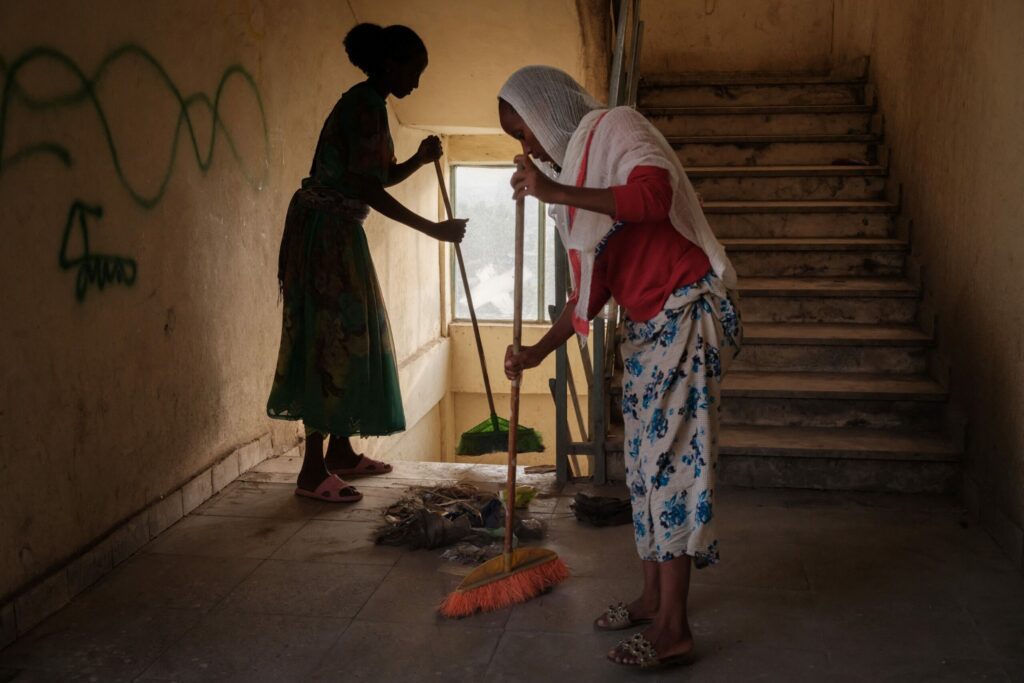This op-ed was originally published in Newsweek.
It’s been over a year since peace arrived in Tigray, but displaced women and children still huddle in concrete classrooms—schools that have not been used for learning in years. Rather, they have become temporary homes for many displaced families who have experienced horrific violence and have the scars to prove it. Food is hard to come by. Most are still desperate for more aid, and live in precarity, fearing that peace will not hold.
Northern Ethiopia’s Tigray region was one of the world’s worst humanitarian crises in 2021 and 2022. It has since been crowded out of the headlines, but the situation remains dire. An estimated 600,000 were killed during the two years of fighting between Tigrayan, Amhara, Eritrean, Ethiopian, and other armed groups. Much of Tigray lived under siege for nearly two years, receiving almost no food, medicine, or humanitarian assistance.
While much of the fighting ended in November 2022 with the Pretoria Agreement, some parts of Tigray are still in conflict, and the civilian population is receiving limited humanitarian assistance. The U.S. government recently resumed food aid across Ethiopia after a pause in 2023 due to aid diversion and widespread corruption. This was welcome news, as those who rely on that assistance have paid dearly.
Ethiopia hosts 4.38 million internally displaced people (IDPs)—one of the highest IDP populations in the world. Some 1 million of those IDPs are in Tigray. They are living with family, in schools, and in some cases, camp-like settlements. Most of these locations are crowded, unsanitary, and unsafe. While most IDPs insist that they hope to return home, it is hard to see how that will happen anytime soon. Damaged infrastructure, a lack of services, and ongoing insecurity—particularly in western and southern Tigray where Eritrean and Amhara forces are still present—make that unlikely anytime soon.
Refugees International learned just how desperate conditions are on a recent visit to Tigray. As they waited for food aid to resume, many IDPs that Refugees International spoke with had only a small amount of donated food from the community to feed their children. Others took to eating whatever they could find. One woman was feeding her children a hardened root that is normally only fed to cattle. Others ate only a small portion of donated bread from a local nun. According to numbers from Tigray health officials, 60 percent of households have moderate or severe hunger, compared to only 3 percent before the war. Shockingly, this rate is now even higher than during the war and blockade (almost 36 percent).
Women in particular bear physical and mental scars of a brutal conflict. The conflict in Tigray was marked by widespread sexual violence endured by women and girls. Researchers estimate that some 43 percent of women faced gender-based violence, and of those who were raped, nearly 70 percent were gang raped, some in front of their families until losing consciousness. And the real numbers are surely higher, as many women do not report their cases due to stigma. Health workers indicated that many women bear extreme physical scars and emphasized that finding mental health care is difficult. There are only eight psychologists in the entire region of nearly 7 million people. Others find it difficult to care for the infants and toddlers that were conceived from the rapes. They are a constant reminder of the horror they faced. Coupled with hunger and trying to care for children with inadequate housing and few resources at hand, it is almost impossible to discuss solutions like return or integration. For many, daily survival is all that is possible right now.
Much more is needed for Tigrayans to start to rebuild their lives, and for the fragile peace to hold. Alongside the resumption of food assistance, international actors like the United States must pressure Ethiopia to uphold the Pretoria Agreement. In addition, donors and aid agencies must also invest in Tigray, including in mental health services for those bearing the scars of war and conflict-related sexual violence. Surprisingly, the aid community has a relatively small presence there now. And while local organizations have the best knowledge and skills to support their population, donors and aid agencies have massively underinvested in them.
Tigray is trying to claw its way back from years of war, but the civilian population needs much more help. Without assistance, there is a risk that Tigray will not recover. In addition to greater human suffering, a continued lack of even the most basic services and aid could destabilize the region and jeopardize peace. At a time when Ethiopia is facing tensions in other parts of the country and new conflicts are erupting in the wider Horn of Africa—from Somalia to Sudan—Tigray must not be forgotten.
Featured Image: Women, who fled the violence in Ethiopia’s Tigray region, sweep stairs after sunrise at May Weyni secondary school, that turned in to a Internal Displaced People (IDP) camp in Mekele, the capital of Tigray region, Ethiopia, on June 23, 2021. (Photo by Yasuyoshi Chiba/AFP via Getty Images).
Source link : https://www.refugeesinternational.org/tigray-is-still-in-crisis-the-guns-have-stopped-but-hunger-abounds/
Author :
Publish date : 2024-02-02 08:00:00
Copyright for syndicated content belongs to the linked Source.
